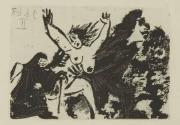La Célestine
Artist: Pablo Picasso (Spanish (active France), 1881-1973)
Publisher: Éditions de l'atelier Crommelynk, Paris, 1971
Printer: etchings and aquatints: Fernand Crommelynk, Paris; text: Fequet et Baudier, [Paris]
Binder: Bernard Duval, [Paris]
Author: Fernando de Rojas (Spanish, 1465-1541)
Date: 1971
Dimensions:
Slipcase: H: 9 in. (229 mm); W: 7 in. (178 mm); Depth: 1 13/16 in. (46 mm).
Book: H: 8 1/2 in. (216 mm); W: 6 7/8 in. (174 mm); Depth: 1 9/16 in. (39mm).
Page (bottom edge untrimmed): H: 8 1/4 in. (210 mm); W: 6 3/8 in. (162 mm).
Medium: Original prints: 66 etchings and aquatints.
Text: letterpress (typeface: Garamont, 10 pt.).
Paper: off-white Richard-de-Bas laid paper (watermark: LA CÉLESTINE).
Classification: Books
Credit Line: Gift of Molly and Walter Bareiss in honor of Barbara K. Sutherland
Object number: 1984.944
Label Text:Pablo Picasso, La Célestine (Celestine). Text by Fernando de Rojas (1971)
When La Célestine was first published in 1499, Fernando de Rojas was thought to be the author. Today, most scholars believe he only wrote part of it. The book was an immediate success and remains one of the greatest works of Spanish literature.
The leading character of the story is a “Trotaconventos,” a matchmaker who tries to bring together two innocent lovers. Her motive is greed and her corruption knows no bounds. All of the characters are tragically and hilariously doomed from the beginning. The original title was La Tragicomedia de Calisto y Melibea (the names of the lovers) and it was written as a play in 21 acts.
Picasso worked on the plates for this project every day from March 16 to October 5, 1968. As soon as he would complete a plate, it was printed and brought back to the artist for revision. Picasso used a wide variety of processes, experimenting in particular with lift-ground or soft-ground etching, which is a form of aquatint. Besides the prints needed for the book, another edition of the etchings was printed to be framed and hung as separate images. All together, 29,700 images were printed for this project.
When La Célestine was first published in 1499, Fernando de Rojas was thought to be the author. Today, most scholars believe he only wrote part of it. The book was an immediate success and remains one of the greatest works of Spanish literature.
The leading character of the story is a “Trotaconventos,” a matchmaker who tries to bring together two innocent lovers. Her motive is greed and her corruption knows no bounds. All of the characters are tragically and hilariously doomed from the beginning. The original title was La Tragicomedia de Calisto y Melibea (the names of the lovers) and it was written as a play in 21 acts.
Picasso worked on the plates for this project every day from March 16 to October 5, 1968. As soon as he would complete a plate, it was printed and brought back to the artist for revision. Picasso used a wide variety of processes, experimenting in particular with lift-ground or soft-ground etching, which is a form of aquatint. Besides the prints needed for the book, another edition of the etchings was printed to be framed and hung as separate images. All together, 29,700 images were printed for this project.
Not on view
In Collection(s)















